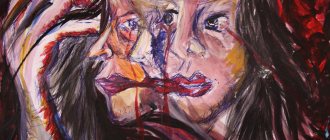Dysthymia is a mood disorder characterized by symptoms of depression. But unlike depression, dysthymia is a chronic disease with less profound manifestations. That is, depression has a shorter course, but more expressive symptoms than dysthymia.
General information
Dysthymia is a mental disorder that has a chronic course and is manifested by such signs as a depressed emotional state without the presence of pronounced behavioral disorders and somatic pathologies.
This is a mild form of depression. With this pathology, patients feel sadness, reluctance to engage in everyday activities, do not feel pleasure, and are often angry and gloomy. However, due to the lack
https://www.youtube.com/watch?v=https:accounts.google.comServiceLogin
people with dysthymia can work and function relatively normally in society. Dysthymia is determined by specialists based on symptoms such as low mood and apathy, which have been present in the patient for two years. Psychiatrists also pay attention to the presence of insomnia, appetite disturbances, increased fatigue, a feeling of weakness and decreased concentration.
Such phenomena allow the doctor to diagnose dysthymia. This means that when a disease is identified, you need to choose the right treatment tactics. For this pathology, treatment must be comprehensive. It is advisable to apply an individual approach to each patient depending on the conditions in which he lives.
Treatment and prevention of pathology
Dysthymia is treated with psychotherapy and medication. Antidepressants are among the main group of medications that help combat the disorder. Many patients are wary of these drugs, but modern antidepressants for the most part do not carry the negative side effects that the drugs were characterized by before.
Shortly before the start of therapy, the doctor prepares the patient for the fact that the course will take a certain time - this is not a matter of two or three days. The main task is to eliminate the patient’s symptoms of the disease, as well as consolidate a positive result.
The doctor individually determines the dosage of the medicine and its immediate choice in each specific case. The specialist also determines the duration of treatment.
Dysthymia is a mental disorder that can be easily corrected. The sooner you decide to seek help, the faster you can achieve success in treatment.
Subsequent prevention of the disorder will also be determined by the doctor depending on the individual characteristics of the course of the disease. Usually it is aimed at a healthy lifestyle, increasing self-esteem, maintaining a sleep, work and rest schedule, and a balanced diet.
Dysthymia symptoms
Dysthymia and symptoms of the disease manifest themselves in decreased mood with the following manifestations: decreased or increased appetite, drowsiness or insomnia, lack of energy, fatigue, decreased self-esteem and concentration, difficulty making decisions, feelings of hopelessness, pessimism, inability to feel pleasure - anhedonia.
Dysthymia is diagnosed if the disorder lasts for up to two years. The disease is typical for young people, but a person often becomes aware of his diagnosis many years after the onset of the disease. If dysthymia manifests itself in childhood, the patient considers himself depressed, and attributes all symptoms to character traits.
The diagnosis of dysthymia is established only if symptoms have been present for two years with a short break (up to two months). Manifestations of the disease should not be associated with the use of drugs, medications, or alcohol.
Dysthymia is not diagnosed if the patient has episodes of mania, depression, hypomania, cyclothymia, schizophrenia, or delusional disorder. For children, as well as adolescents, the onset of symptoms for one year is enough, and not for adults two years. After three years of the disease, symptoms of severe depression may appear. In these cases they talk about double depression.
Up to 75% of patients with dysthymia have chronic diseases of organic origin or psychological disorders. There are combinations of this disease with a panic attack, social phobia, generalized anxiety, and somatic diseases. People with dysthymia are at high risk of developing depression.
This disease is characterized by the following manifestations:
- Depressed emotional state.
- Inability to experience joy (feelings of happiness are caused only by special situations, ordinary life causes melancholy).
- Increased anxiety.
- Closedness.
- Increased excitability.
- Fears (fear of fatal diseases, accidents, failures, poverty).
- Tearfulness.
- Feeling of own uselessness.
- Dissatisfaction with one's personality, environment, life in general.
- Constant anticipation of unpleasant events.
- Increased fatigue, decreased cognitive function.
- Lack of vigor and ability to make decisions.
- Sleep disorders.
- Decreased or increased appetite.
- Weight loss or weight gain.
These are common signs of this mental disorder. However, dysthymia is a disease that is divided into several types.
Primary and secondary dysthymia occurs. The first type arises on its own. The second appears in connection with other mental disorders. The cause of dysthymia can be diseases of any organs and systems, as well as stressful situations. Based on the signs that manifest themselves against the background of the disease, dysthymia is divided into somatized and characterological. These types of pathology are discussed in detail in the following sections of the article.
In order to prescribe adequate therapy, the doctor must accurately determine what disease the patient has. The difficulty in diagnosing dysthymia lies in the fact that its symptoms are similar to those of other mental disorders, and patients are often uncritical of their condition. They often refuse to seek medical help, believing that the unpleasant symptoms will soon pass.
- Survey of the patient and conversation with him.
- Identification of the totality of signs of dysthymia present in the patient.
- The presence of characteristic pathological phenomena for two or more years.
- Signs of dysthymia in the absence of symptoms of other mental disorders.
In order to identify this disease, doctors also conduct testing. When making a diagnosis, the psychiatrist pays attention to such manifestations as:
- Increased or lack of appetite.
- Sleep disorders.
- Lack of positive emotions from things that previously made a person happy.
- Feeling of hopelessness.
- Inappropriately low assessment of one's personality.
- The constant presence of symptoms for two years, short-term improvements or no improvements at all.
- Attacks of anger (usually in people of adolescence).
The presence of most of the above signs gives grounds for a diagnosis of dysthymia. Treatment of the disease, as a rule, does not involve placing the patient in a hospital. The exception is situations when the symptoms of pathology prevent a person from living a normal life.
Unfortunately, the answer to the question of whether dysthymia is completely curable is negative. Therapy is usually long-term, and recovery is rarely one hundred percent. The disease provokes many difficulties in work and personal life. Patients are often prone to suicidal thoughts and suicide attempts.
- You need to have hobbies and devote enough time to them.
- You should follow a sleep schedule and get proper rest.
- It is important to try to establish contact with family and friends and maintain social connections.
- You need to lead a healthy lifestyle, give up addictions, and not neglect sports.
- You should eat well and regularly.
- You need to develop positive thinking in yourself.
- You should discuss your problems with family, friends or a therapist.
Compliance with such preventive measures will allow a person to protect himself from the occurrence of mental disorders such as dysthymia.
Symptoms of dysthymia
The main symptom of the disease is considered to be chronically low mood. The situation with a general basement condition can be observed for two years or more.
Check out the list below. If you have two or more symptoms, you may have a disorder
:
- Sleep problems, manifested in the form of insomnia, early awakenings, obvious drowsiness during the day.
- Disturbed eating behavior caused by decreased appetite or excessive overeating.
- Constant lack of energy and fatigue.
- Low self-esteem, feelings of personal worthlessness, tendency to self-criticism, self-flagellation.
- A systematic feeling of emptiness, reluctance to think about anything.
- Slow reaction, distracted attention, inability to make quick decisions.
- Loss of interest in usual hobbies and reluctance to do what you once liked.
- Periodic headaches, cardiovascular diseases, joint pain, and other ailments that cannot be eliminated with medications.
- Pessimism, doubts about one's future.
- Thoughts about suicide.
Factors provoking the disease
Pathology occurs as a result of various reasons - both external and internal. The main factors that trigger the development of the disease include the following:
- Genetic predisposition. In families where cases of the disease have occurred, it can even occur in children. However, parents often confuse dysthymia with manifestations of the personal characteristics of their son or daughter.
- Brain dysfunction (insufficient production of the hormone serotonin).
- Nervous stress, troubles at work, difficulties in personal relationships.
- Lack of sleep.
- Unbalanced diet.
- Unfavorable family environment, lack of parental attention or lack thereof (in minors).
- Personal characteristics (increased anxiety, vulnerability).
- Constant physical and emotional stress (for example, in military personnel).
So, dysthymia is a mental disorder that occurs under the influence of various factors. Therefore, each case must be considered individually.
Symptoms, signs of dysthymia
The disorder usually begins slowly. Most often, the first symptoms appear in early adulthood. The disease has a chronic course. In childhood dysthymia, symptoms and signs include inability to learn and interpersonal relationships. Common in children and adolescents:
- irritability;
- touchiness;
- low self-esteem;
- pessimistic mood;
- sometimes eccentric.
Before the development of these signs, a person is exposed to greater stress and traumatic life events. Fluctuations between mild depression and periods of relatively normal mood vary.
Dysthymia significantly affects a person’s quality of life - it disrupts adaptation at work and in personal life, it can lead to avoidance of society, and make it difficult to enjoy free time. The quality of life of patients with this disease is worse than that of people with arterial hypertension, diabetes, and arthritis.
Manifestations typical of dysthymia:
- increase or decrease in appetite, weight;
- lack of sleep or excessive sleepiness;
- frequent fatigue;
- weakness;
- decreased self-confidence;
- disturbances in concentration;
- indecision;
- hopelessness;
- pessimism.
The symptoms of dysthymia are similar to those of depression, but are less severe. Both diseases are characterized by a bad or irritable mood, lack of interest in pleasant, joyful things, and loss of energy. Symptoms may worsen to the point of developing classic depression.
Dysthymia is a stable, long-term disorder and is therefore perceived as part of a person’s character. A sick person does not even discuss his problems with his doctor, family, or friends.
It is impossible to say whether people with this disorder are under more pressure than others, or whether they are more susceptible and less able to cope with various difficulties.
Dysthymia and Cyclothymia
Dysthymia must be differentiated from cyclothymia, which is accompanied by manifestations of a mental, affective disorder, which is characterized by mood swings between manifestations close to dysthymia and hyperthymia with episodes of hypomania.
With cyclothemia, pathological changes occur as separate or double episodes, separated by mental health conditions or alternating continuously. The concept of cyclothymia was originally used to describe bipolar disorder, and the traditional classification considers it as a mild and unexpressed variant of general cyclophrenia.
Dysthymia test
We suggest taking a fairly simple test that will help you determine whether you have dysthymia. So, read the questions and give yourself one point for each positive answer.
Questions
:
- Does it take a lot of effort to make you happy?
- Do you often notice that you are in a depressed mood?
- When you smile, don't you always actually feel happy?
- Do you find it difficult to switch off from all your worries and start having fun?
- Do your everyday life go by without expecting any joys from life?
- Do you tend to be pessimistic about your own life?
- Do you often think about something unpleasant?
- Do you think your life is very difficult?
- Do you consider your own life to be meaningless?
- Do you lose your temper easily and despair when you fail?
- Do you often feel guilty?
- Is your conscience tormenting you because of past mistakes?
- Can you be called an insecure person?
- When talking about your failures, do you feel ashamed and uncomfortable?
- Do you not really like to talk a lot and prefer to remain silent in conversations?
- Are you cool with telling jokes?
- Do you feel discomfort when being in the company of confident and happy people?
- Is sunny weather not having any positive effect on your overall mood?
Now count up all positive answers in points
:
- 0-11
– you don’t have to worry about having dysthymia. - 11-14
– you are close to dysthymia or its initial stage. - 15-18
– you undoubtedly have dysthymia, which can turn into serious depression, so be sure to take action.
Who is most at risk of getting sick?
Most often, this mental disorder begins to manifest itself in youth, sometimes it occurs in minors. However, there are types of disease (for example, endoreactive dysthymia) that are observed in older people. As a rule, the pathology manifests itself within two years and even over a longer period of time.
A depressed emotional state is observed in patients for 2-3 months or more, and periods of improvement are short-lived. The younger the patient, the more pronounced his symptoms. Most patients with dysthymia suffer from other types of mental pathologies: schizophrenic or manic-depressive disorder, panic attacks, phobia, addiction to alcohol or drugs. However, in general, patients are not characterized by pronounced disturbances in social adaptation.
Diagnostics
To be diagnosed with dysthymia, a patient must have at least 3 of the following symptoms:
- decreased energy, activity, fatigue;
- sleep disorders, insomnia;
- low self-confidence;
- problems with concentration;
- decreased interest in sex and other pleasant things;
- hopelessness, despair;
- problems solving everyday problems;
- pessimism;
- social isolation;
- decreased productivity;
- crying, regret.
Patients also often suffer from physical symptoms. The disorder worsens in the simultaneous presence of chronic physical illness.
Alternative Treatments for Traumatic Rape Syndrome Relaxation
The disease is very difficult to treat, since there is a strong resistance to it, which is characterized by the constant presence of signs of mood disorders, but not leading to a depressive state.
It happens that depressive manifestations within the framework of dysthymia become more complicated and a clinical picture of severe depression is noted. This condition is called double depression.
There are reviews from patients that this disease responds well to treatment with Sertraline at a therapeutic dose of 50 mg per day. Patients often make mistakes when taking antidepressants from different groups or when unsystematic treatment was carried out in the early phases of treatment.
Dysthymia includes the following antidepressants in treatment: Amelipramine, Imipramine, Amitriptyline, Anafranil, Clomipramine.
Such drugs as Sulpiride and Amisulpriide give good results. Sulpiride is an atypical antipsychotic that has a moderate antipsychotic effect with a weak antidepressant and psychostimulant effect. It is necessary, under the supervision of doctors, to carry out consistent and correct treatment according to specially selected regimens.
Amisulpriide is an antipsychotic that belongs to the atypical antipsychotics. The antipsychotic effect is combined with a calming (sedative) effect.
Cognitive psychotherapy is of great importance in the treatment of dysthymia. Individual psychotherapy, group therapy, as well as support groups have successfully proven themselves, allowing the patient to develop interpersonal communication and assertiveness (open, direct behavior), increasing self-confidence.
https://www.youtube.com/watch?v=ytdev
Prevention of dysthymia includes timely detection of signs of this disease and increasing a person’s level of self-esteem.
In addition to any therapy, the patient should learn deep muscle relaxation or progressive relaxation. These techniques can help the victim overcome anxiety attacks, help him cope with sleep disturbances, and reduce the likelihood of outbursts of tearfulness and headaches (Rosenhan et al., 1989).
Bottom line
Dysthymia is a chronic condition characterized by both isolated and recurrent episodes. Treatment of the disorder is one of the most pressing problems of modern medicine. In the world, this disease causes a high percentage of cases of decreased ability to work. The use of antidepressants in practice has revolutionized not only the treatment of dysthymia, but also the perception of it.
Despite a number of studies conducted to study the relationship between personality type and depression, the role of concomitant personality disorders in relation to the disease and its treatment remains a relatively little-studied problem.
IMPORTANT! Informational article! Before use, you should consult a specialist.
Somatized dysthymia
This type of disease is characterized by the fact that a person constantly notices signs of pathologies in various organs. For example, he may complain of pain in the heart, stomach and intestines. An acceleration of heart rate, constipation, breathing problems, sensitive and restless sleep may be observed. A person begins to fear for his health.
There may be fears about the emergence of serious diseases. Many patients diagnosed with somatized dysthymia experience fear of oncological pathologies, the development of heart attacks, strokes, and so on. They constantly listen to their body, worry and despair about their own health. This type of pathology resembles hypochondria.
Characterological dysthymia
This form of mental disorder is characterized by the constant presence of a pessimistic mood. Patients do not receive satisfaction from everyday events and feel sad all the time.
Previously, these characteristics were considered personality manifestations. Today, mental health professionals are not convinced that this view is correct. Psychiatrists believe that constant pessimism indicates the presence of dysthymia. It should be added that, in addition to depression, the condition of such patients is characterized by periodic statements about the hopelessness of life and their own uselessness.
Patients look lethargic, sad, apathetic, they take even minor troubles to heart. Such people grumble all the time, they are dissatisfied with their surroundings, are uncritical of their own condition, and tend to blame others for all troubles. Because of this behavior, even family and friends who used to empathize with the sick begin to shun them over time.
Cyclothymia and dysthymia: differences
Some people confuse cyclothymia and dysthymia. What are their differences?
Cyclothymia
Chronic instability of mental state, in which mild depression alternates with high spirits. Young people are usually susceptible to this instability. Subsequently, it becomes chronic, but at times the mood can be normal for several months. It is difficult to make a diagnosis if the patient is not seen by a specialist for a long period, and because of this, many people do not even suspect that they have an illness.
Dysthymia
With dysthymia, there are no long periods of elation or normalization of mood. At the same time, some patients may evaluate some periods as relatively good, but even during them they continue to feel tired and lack of energy. That is, the main difference is that a person almost constantly feels oppressed. Of course, such a condition is much easier for doctors to identify than cyclothymia.
Dysthymia in a child
Sometimes the causes that trigger the disease mechanism appear in childhood. The psychological climate in the family where the child is being raised is of great importance. If the relationship between parents is hostile, they constantly argue - this can provoke the development of a mental disorder in children.
When the joyful mood of a son or daughter is condemned, they are forced to hide it. As a result of this, the child becomes apathetic and loses the ability to enjoy the things that made him happy before. What disorders are characteristic of dysthymia in childhood? How to recognize the disease? First of all, it should be a warning sign for parents if the child constantly looks sad.
It is suspicious if he seems tired all the time, his social circle has narrowed, and there are no manifestations of joy from gifts and delicacies that previously evoked pleasant emotions.
How to treat dysthymia?
To combat the symptoms of the pathology, doctors recommend drug therapy. As a rule, the patient is prescribed antidepressants that increase the production of serotonin. Most drugs used today do not cause serious side effects. In order to achieve tangible results, medications must be taken for about six months.
To combat increased excitability and insomnia, sedatives are recommended. A visit to a psychotherapist plays an important role in the treatment of dysthymia. These can be individual, group or family sessions. Psychotherapeutic techniques allow the patient to better adapt to society, solve problems in relationships with others, and cope with stress.
Treatment of pathology
Unlike depression, dysthymia is less successfully treated with medication. Therefore, drug therapy is recommended only if other methods and procedures are ineffective.
Pharmacological treatment
Drug therapy consists of prescribing antidepressants aimed at capturing serotonin at receptors. According to the doctor's decision, drugs from the group of anxiolytics (medicines for relieving anxiety) and mood stabilizers are also used.
Medicines may have side effects. SSRIs can cause nausea, sexual dysfunction, increase anxiety at the beginning of treatment, and lead to long-term apathy. Concerns about the increased risk of suicide have led the US Drug Administration (FDA) to recommend warnings on these drugs. The increased risk of suicide has not been scientifically proven, but a small percentage of people taking the medications feel surprisingly worse than before starting treatment. All problematic changes must be reported to the doctor and the dates of visits must be observed. The risk of untreated depression is much higher than the risk of taking antidepressants.
It takes 2–6 weeks for antidepressants to take effect. It is important to adhere to the dosage prescribed by your doctor. It may take several months to achieve the full effect.
Psychotherapy
Psychotherapy is used as the first choice treatment approach, focusing on acquiring skills to combat melancholy, understanding its essence, and therefore preventing the duration and intensity of the symptoms of the disorder.
What is important is the patient’s ability to learn to cope with stressful situations, communicate with family and loved ones, who play a significant role in alleviating dysthymia. Treatment also consists of education, providing information about the nature of the disease, depression, eliminating self-critical thoughts, strengthening interpersonal relationships, self-confidence, and increasing self-esteem.
Treatment resistance
Treatment-resistant depression is a cause of decreased ability to work in patients. About 50% of people suffering from depressive disorder do not achieve remission after using antidepressants. They are classified as treatment resistant. Current pharmacological and psychotherapeutic strategies for treating this disorder have limited effectiveness, and new treatment options must be sought. The most commonly used therapeutic modalities are drug combinations or substitutions.
The reasons for the lack of effectiveness of treatment vary. These include:
- incorrect diagnosis (eg, lack of concomitant pathology);
- insufficient dose of antidepressants;
- short duration of drug use;
- low patient cooperation (about 50% of patients stop treatment prematurely or do not use the recommended dose of medication for various reasons);
- anxiety, stress associated with stigmatization;
- insufficient medicinal effectiveness;
- unpleasant side effects (sedation, poor health, weight gain, sexual dysfunction).
Here we are talking about pseudo-stability. Considering the above-mentioned factors, the European multicenter study also identified other clinical factors associated with treatment resistance. These include:
- comorbid personality disorder;
- comorbid anxiety disorder;
- early age of onset of the disease;
- insufficient response to the first antidepressant.
Diagnosis of dysthymia and treatment of pathology
https://www.youtube.com/watch?v=ytcreators
Immersion (immersion in a trauma situation)
In this technique, the patient is taught progressive relaxation and then a fast-acting defect to the feared object is presented (Zimbardo, 1985). Immersion is not the best method for working with a client suffering from rape traumatic syndrome, as it is a very specific method and in its original form is too disgusting for the client.
Also, this method does not involve what the victim needs most: support. However, rapid immersion in imagery can be used to reduce anxiety caused by nightmares and flashbacks (see above) (Matlin, 1989). Although this technique can be used with some patients, it should be used with caution as there may simply be patients who do not take it.
Cognitive behavioral therapy is a combination of methods and principles of both cognitive and behavioral therapy. This combination can be beneficial for a rape victim, as the victim often needs to learn new skills in order to cope with her situation and anxiety.
In Resick's (1988) study, stress inoculation, for example, produces long-lasting effects. In stress inoculation, as in other cognitive behavioral techniques, the patient goes through three stages. The task of the 1st stage is for the therapist (also the patient himself) to reveal the patient’s existing skills and coping skills.
This stage may also include an educational component in which victims learn more about the process of developing fear and anxiety that follows rape. In stage 2, new coping skills are acquired. The patient studies progressive relaxation, new cognitive techniques such as thought stopping, guided self-dialogue and hidden rehearsal.
At the 3rd stage, the application of these techniques in practice is trained. The patient trains new skills in non-dangerous but fear-inducing situations. Thus, she (the victim) learns to control fear and tries to stop avoidance behavior (Zimbardo, 1985; Resick, 1988). Stress inoculation programs can be used in individual therapy or group therapy for rape victims. This program has a number of advantages that will be discussed below.
Currently, the following main groups of methods are used in behavioral psychology:
- stimulating motivation for behavior change;
- correction of emotional disorders,
- methods of self-regulation;
- cognitive restructuring methods;
- methods of extinguishing unwanted behavior;
- methods for developing positive behavior.
Systematic desensitization
Systematic desensitization is often used to treat patients with anxiety and fears. Frank conducted a study in 1988 comparing SD with cognitive behavioral therapy in the treatment of rape victims. Both techniques proved to be very successful. First, the victim is taught progressive muscle relaxation using the Jacobson method.
In the case of rape victims, the instruction should not allow your thoughts to wander, as they are likely to wander around scenes of sexual assault. It is better if they (the victims) could be instructed to focus their thoughts on a specifically pleasant, happy scene. Then, the patients' chief complaint is divided into several scenes, which are ordered hierarchically.
Cognitive therapy
Cognitive therapy attempts to change irrational or erroneous beliefs, expectations, evaluations, and attributions. The rape victim may benefit greatly from cognitive therapy, especially in dealing with self-blame, anxiety attacks, and some aspects of sleep disorders (Rosenhan et al., 1989).
A woman who feels guilty and blames herself probably has difficulties with attributions and evaluations. Anxiety attacks express some distortions of expectations and assessments. The therapist can work with these problems at a cognitive level. It can explain how and why fear and anxiety develop following rape, why the victim tries to attribute blame, and why she has inappropriate automatic thoughts.
Repeated, coping imagery of a situation can be used to reduce the severity of the effects of anxiety attacks and sleep disorders. The combination of imagery with deep muscle relaxation is also very useful. Situational reduction in intensity during imagery can be used to work with scenes in which the patient is experiencing trauma.
Likewise, an assertive, confident presentation of situation can be used when working with clients who feel vulnerable in many situations around them (Rosenhan et al., 1989). The victim might represent as vividly as she herself can do as an assertive person in a situation she is afraid of. This helps her make such thoughts habitual and the image of the situation becomes less threatening.
To work with anger reactions and anxiety attacks, the therapist may use assertiveness training (Rosenhan et al., 1989). Resick (1988) also describes assertiveness training used in group therapy for rape victims. But resick et al. included an educational part in the training, during which the patient learns about the development of anxiety and fear in the event of rape.
There are explanations for how assertive responses have been used to counter fear and reduce avoidance. The reason is that assertive responses are incompatible with fear. Assertiveness training can be useful in dealing with interpersonal problems. In resick's study, victims were trained to change non-assertive cognition and erroneous thinking patterns. Also, several sessions focused on covert and behavioral rehearsal of assertive responses.
Group therapy
https://www.youtube.com/watch?v=ytpress
The impact of group therapy is very beneficial for rape victims. Many rape crisis centers are based on crisis theory and psychotherapeutic support groups. The pillars of this approach are dissemination of information, active listening, and emotional support (Resick et al., 1988).
The group's shared experience can influence patients' insensitivity, isolation, and fear of rape (Rosenhan et al., 1989). Cryer and Beutler (1980) found that most group members became noticeably more competent in measures of anxiety and fear. Supportive psychotherapy may include not only the exchange of feelings, perceptual experiences and support, but also a teaching phase.
Victims may be given information regarding fear and anxiety. Support group members choose their own topics for discussion (Resick et al., 1988). They often include themes of fear, anxiety, the reactions of family and friends, and their own reactions to the rape and to stimuli that resemble the trauma for them.
Group therapy can also be combined with art therapy. McCay (1989) describes how victims of sexual assault were able to overcome their damaged feelings through face painting, storytelling, doll making, and autobiographical activities. In this group, victims began to talk about generalized stalking and assault and came to understand, re-energize, and subsequently, alleviate some of the painful impacts of their experiences.
Hypnosis
Hypnosis is another option for finding ways to help victims of sexual assault. While under the influence of hypnosis, victims may find relief from fears, feelings of helplessness, anxiety, and social isolation (Ebert, 1988). Hutchinson (1986) suggests that a feminist self-hypnosis group help victims relieve their inappropriate feelings of guilt and enable them to understand the social context of the attack.
Hypnosis can also be used in combination with family therapy. For example, Somer (1990) tried brief hypnotherapy on a rape victim and her husband simultaneously. Hypnosis allowed the victim to share her experience with her husband, who, for his part, was also too upset and angry whenever the victim wanted to share her feelings about the rape with him.
Under the influence of hypnosis, the traumatic scene changed shape, and the result corrected the behavior on the part of the husband and the expression of anger towards the rapist. This technique helped the husband cope with his anger in much better ways, and helped the victim reduce her feeling of abandonment and abandonment.
Chapter IV. Deviant behavior
A humanistic approach must be applied to all possible types of therapy. Since the patient needs understanding, acceptance and support from the therapist. Client-centered therapy would help the victim express himself, consider different ways of responding, and choose the most appropriate way from among them.
In psychology, the term behavior is widely used to denote the type and level of human activity, along with its manifestations such as activity, contemplation, cognition, and communication.
Initially, behavior was understood as any external observable reactions of an individual (motor, vegetative, speech), functioning according to the “stimulus-response” scheme. In 1931, one of the founders of behavioral psychology, John Watson, spoke of behavior as “a continuous stream of activity that begins at the moment of fertilization of the egg and becomes increasingly complex as the organism develops.”
In the psychological dictionary, behavior is defined as “the interaction inherent in living beings with the environment, mediated by their external and internal activity.” External human activity refers to any external manifestations: movements, actions, deeds, statements, vegetative reactions.
https://www.youtube.com/watch?v=ytabout
Behavior is a process of interaction between an individual and the environment, mediated by individual characteristics and internal activity of the individual, which takes the form of predominantly external actions and deeds.
One of the most essential properties of human behavior is that it is social in its essence - it is formed and implemented in society. Another important feature of human behavior is its close connection with speech regulation and goal setting. In general, the behavior of an individual reflects the process of its socialization - integration into society. Socialization, in turn, involves adaptation to the social environment, taking into account individual characteristics.
Psychodynamic therapy
Psychodynamic therapy is not an appropriate, appropriate treatment for rape victims, as questions about childhood experiences may leave the victim feeling guilty. The only exception may be cases of patients who have experienced not only rape, but also sexual assault in childhood.
In such a case, psychodynamic therapy can help the victim; however, even in the case of such a patient, this type of treatment cannot be applied at the beginning of the course of treatment. It is better, after the victim has coped with the rape to some extent, the therapist can return to her childhood to work with previous experiences.
Regarding the Freudian point of view, it should be mentioned that sublimation is used as a defense mechanism against trauma. Many rape victims give self-defense classes to rape victims and other women, or to volunteers at rape crisis centers. This is an example of sublimation because helping others helps rape victims overcome their own anxiety and fear.
QUESTIONS ABOUT THE CHAPTER










